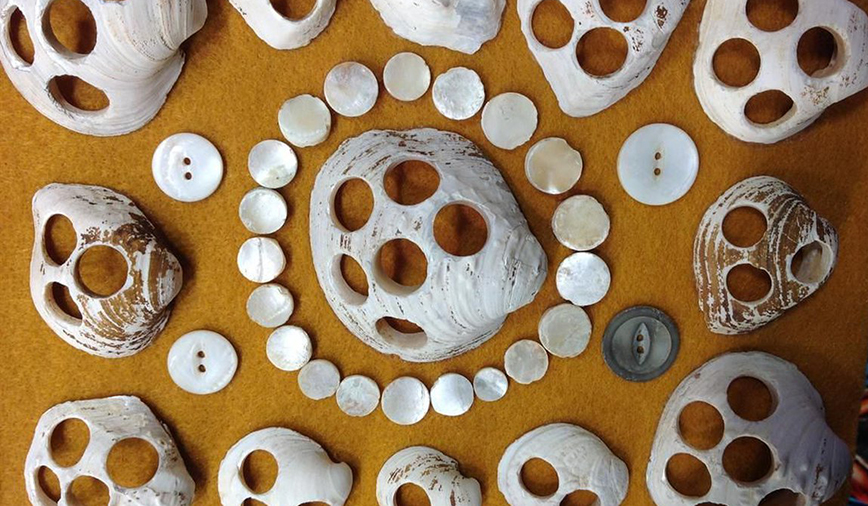January 9, 2015
Buttons
During the late 1800s and early 1900s, freshwater mussels were used to make buttons. Harvests took place throughout the Midwest, including Illinois and our own Fox River. Annual harvests totaled tens of millions of pounds per year. By 1908 many mussel numbers were severely depleted, and many species were near extinction.
Well, I popped a button.
This should come as no surprise, given the way food in general, and fudge in
particular, has been in abundance these past few weeks. But as I looked at the
broken disk, and searched for a suitable replacement, it got me thinking about
buttons. Not so much the cheap plastic kind we have today, but rather the so-
called “pearl” buttons that were common long ago. And they, of course, got
me to thinking about the freshwater mussels in our own Fox River.
If this were 100 years ago and one of us popped a button, the replacement
we’d reach for wouldn’t have been made of plastic. It likely would’ve been
made of mother-of-pearl or, less fancifully, the shell of a freshwater mussel.
Back then, mussels were harvested by the bucket load, and boatload.
Entrepreneurs called clammers, and sometimes industrious kids (you could
earn about a penny a pound), collected the bottom-dwelling, filter-feeding
creatures by hand – and by hook.
Those in it for the “big money” would attach four-pronged “crowfoot” hooks
to a bar, then drag them along a river bottom. Mussels embedded in sediment,
shells partially opened for feeding, would instinctively clamp shut when the
hooks touched their sensitive edges.
Back on the riverbank, the mussels were removed from the hooks and sorted.
Those deemed suitable for button-making were steamed open. The “meat” (an
often gritty mass sometimes used as pig feed) was removed, and the cleaned-
out shells were then shipped to a button factory for processing. In our area,
the largest such facility probably was the Rehbehn Brothers Button Factory in
Yorkville. It was located on the south side of the Fox River near what is now
the Route 47 bridge.
If you happen to find yourself by the river in Yorkville, downstream of the
bridge, take a look along the shore and in the water. Even today, 100 years
after the pearl button industry boom, it’s still possible to find freshwater mussel
shells with uniform circles punched out.
I’ve got a few of these punched-out shells, which we use at the park district
in our aquatic ecology and Fox River programs. But, even when not teaching,
I’m apt to have a shell or two handy, just because I think they’re really cool.
For me the shells, for one, symbolize the struggle of the button cutters – who,
on a good day, might be able to cut 100 pounds of shells and produce 3,600
button blanks. It was messy work, and kind of dangerous too. They were paid
by the piece, and were penalized for excessive waste – that is, not getting
enough blanks from a shell. Six-day work weeks consisting of 10-hour days
might fetch a week’s paycheck of $20. Granted, these weren’t horrible wages
for the times, but they were definitely hard earned.
Our button shells to me also represent the struggle of the mussels themselves.
As if it wasn’t enough that their lot in life is to be bottom-dwelling filter feeders,
these critters also bore the added burden of overharvesting. Only the very
smallest bivalves escaped capture; the rest were turned into buttons.
With no limits on mussel takes, it isn’t surprising that the Fox River clamming industry went bust just a few short years
after it boomed. Although the thinking at the time was that the river was simply becoming too polluted (another sad but
true circumstance), the fact remains that too many mussels were taken. Only recently have their populations grown,
although estimates are that they will never attain the numbers they once had.
So, did I ever get a new button sewn on?
Well, no, not yet. But I did find some more button shells in a bowl on my dresser. A few ancient blanks too. Oh, and
some turtlenecks I forgot I bought last winter. They’re warm and soft and, best of all, button free.
Pam Erickson Otto is the manager of nature programs and interpretive services at the Hickory Knolls Discovery Center, a
facility of the St. Charles Park District. She can be reached at 630-513-4346 or potto@stcparks.org.

